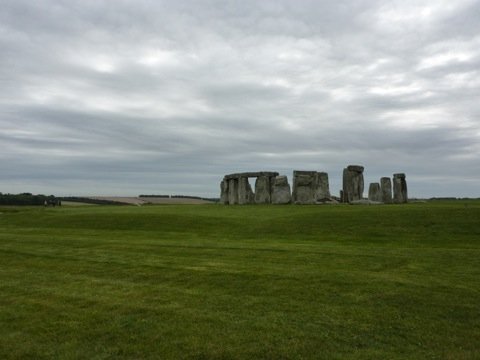
It must be about to time to start posting photos from my trip (blame Alan!) My first destination was in Wiltshire, and is best introduced by Nigel Tufnel:
In ancient times, hundreds of years before the dawn of history, lived a strange race of people: the Druids. No one knows who they were, or what they were doing. But their legacy remains — hewn into the living rock of Stonehenge.
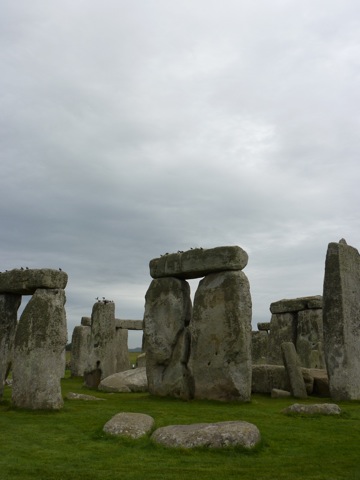
Okay, so having had my fun I should point out that the Druids had nothing to do with building Stonehenge, since they only came along two or three thousand years later. (Damn you, causality!)
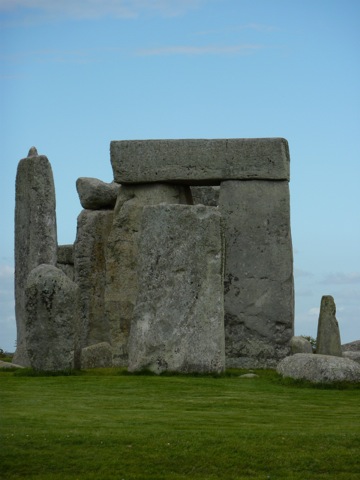
There’s probably not much point in me reciting facts about such a famous and minutely-documented place, so I’ll go for impressions instead. It was a windy and mostly cloudy day, which didn’t detract from the experience at all. The stones just sit there, as stones tend to, while hordes of tourists (not shown) and flocks of birds swirl around them.
(Oddly, most of the tourists seemed to be from all over Russia, as they were keen to make clear from the banners, flags and football club paraphernalia they were displaying. Does Stonehenge hold a special fascination for Russian tourists, or do they just travel around the UK together in convoys?)
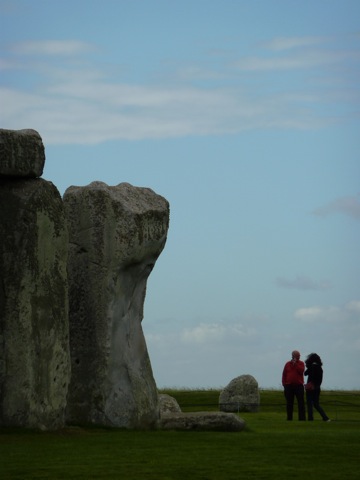
Of course, you can’t actually walk up to the stones, as this photo suggests: the camera sometimes lies. But you can still get a good view as you walk around. I think one of the beguiling things about Stonehenge (aside from its antiquity, mystery, etc) is the way it’s both strongly geometric in plan and tumbled down in nature. It’s somehow very appealing (like a ruined castle, of which more anon).

The Heelstone.
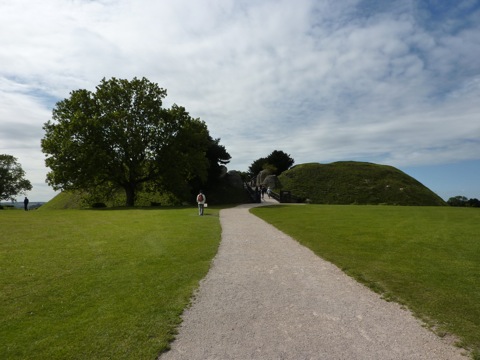
There are many more things to see around Salisbury, but I was just passing through on my way to Exeter and had no time to explore further. But I did get to visit Old Sarum, the most rotten of rotten boroughs. But there was nothing there but some Iron Age hill fort, containing the remains of a later Norman royal castle. It’s sad when a people forgets its past.

If you imagine charging into that ditch and then up the side of the hill, encumbered with a spear and a shield and harrassed by an enemy at the top, you can see that it’s a pretty decent defensive arrangement. In fact, this is just the inner of two defensive earthworks, the Norman motte upon which they raised a bailey.

The view from the top of the other side of the hill, where you can see the remains of Old Sarum’s cathedrals. This explains the rotten borough. Having as it did a cathedral, Old Sarum was obviously a substantial town in the Anglo-Saxon and Norman periods. But following conflict with the castle, in the 13th century the bishop uprooted and relocated to New Sarum, that is Salisbury, and most of the people followed suit. For some reason, however, Old Sarum was given two MPs in 1295 and kept them until First Reform in 1832, by which time it had only eleven voters (none of whom actually lived in the electorate). Which made it very cheap to buy their votes. This seems outrageous to the modern eye, but maybe it should be thought of as an ultra-safe seat where up-and-coming parliamentary talent can be nurtured (or where some piece of dead wood gets to stay afloat whatever the shifts in the political tide).
Incidentally, on the tour bus I was told that Salisbury was spared during the Blitz because its cathedral was used as a navigational landmark by German bomber pilots, as one of them supposedly admitted after the war. It does have the tallest spire in Britain, but even so I can’t see it being much use to pilots flying in the dark at 10,000 feet (even leaving aside the Luftwaffe’s use of radio-direction). This sounds to me like the same sort of story which cropped up in many towns about why they hadn’t been bombed — because of some supposed personal connection with an enemy leader, or the presence of a cultural treasure, or its intended use after occupation by the enemy. In Dresden, there were rumours that Churchill’s aunt lived there, which presumably ceased to circulate after 13 February 1945.

A very short stairway to heaven. Part of the royal palace (Henry II was fond of imprisoning his wife, Eleanor of Aquitaine, here).
Stopping off in Salisbury turned out to be a very nice way to slide back into the country. And it’s quite an airminded area too. Not only was Stonehenge the site of a First World War aerodrome, but nearby Airman’s Cross marks the spot where the first flying fatalities were incurred by the Royal Flying Corps, in 1912. Boscombe Down has been a government aircraft test site since 1939, and the Empire Test Pilots’ School is there also. Spitfires were built at Salisbury during the Second World War. There’s a civilian airfield right next to the hill fort at Old Sarum — light aircraft were constantly flying in while I was there. I even saw a Chinook from the train window. A propitious start!
![]() This work is licensed under a Creative Commons Attribution-NonCommercial-NoDerivatives 4.0 International License.
Permissions beyond the scope of this license may be available at http://airminded.org/copyright/.
This work is licensed under a Creative Commons Attribution-NonCommercial-NoDerivatives 4.0 International License.
Permissions beyond the scope of this license may be available at http://airminded.org/copyright/.


“There was a young curate from Salisbury
Whose manners were quite Halisbury-Scalisbury
He ran around Hampshire
Without any Pampshire
Til his bishop compelled him to Walisbury”
Not sure who wrote that.
Of Old Sarum was home to the School of Army Cooperation and laterley the School of Land-Air Warfare.
Also just up the road is the original home to the RAF Staff College at Andover.
That should say ‘Of course…’ Need a drink to help the typing!
Yes, I forgot about Andover! Middle Wallop is not far away, either — a Spitfire squadron was based there during the Battle of Britain.
When I was a kid, you could walk up to the Stonehenge stones, and also clamber on them (this is back in about 1966, and I have a photo to prove it to myself).
I was expecting this link: http://www.youtube.com/watch?v=eqeq12TdW58&NR=1
Never mind, I’ve got it playing now. Living as well as a banshee, I am.
In ancient times, hundreds of years before the dawn of history …
This sounds like the introductory sentence of most of my students’ papers, sigh.
Re: cities and rumors: IIRC the residents of Hiroshima prior to August 6 1945 were convinced that their relative good fortune was due to General MacArthur having sired an illegitimate child while visiting the town during the Russo-Japanese war.